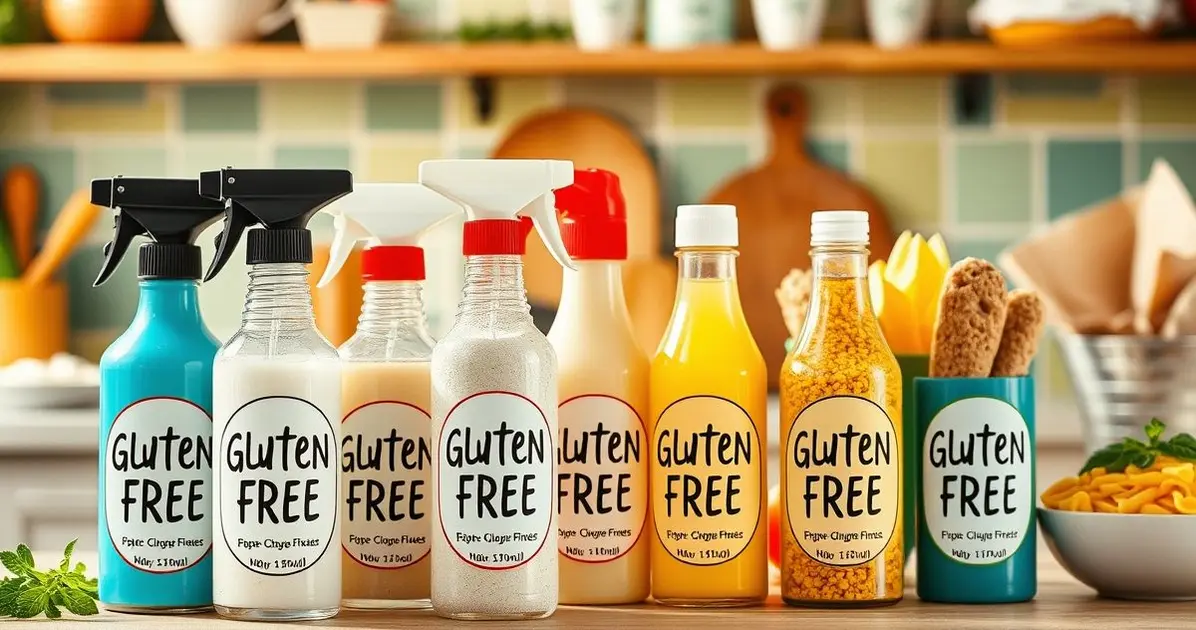When it comes to cooking sprays, many people wonder if they are gluten-free. This is crucial for those with gluten sensitivities or celiac disease, as they need to avoid gluten-containing products. Let’s explore the gluten status of cooking sprays.
Are cooking sprays gluten free

Cooking sprays are often made of oil and additives, but the gluten status can depend on the specific brand and formulation. While many cooking sprays are gluten-free, it’s always important to check labels for clarification or potential cross-contamination.
Understanding Gluten and Its Sources
To grasp whether cooking sprays are gluten free, it’s essential to understand what gluten is and where it can be found.
Gluten is a protein found in wheat, barley, and rye, and it acts as a binder, giving dough its elasticity.
Gluten is commonly present in many foods, including breads, pastas, cereals, and even some sauces and processed foods. For individuals with gluten sensitivity or celiac disease, consuming gluten can lead to serious health issues, making it crucial to avoid gluten-containing products.
In addition to obvious sources, gluten can be hidden in unexpected places. For instance, some processed foods, flavorings, and even certain condiments may contain gluten as a thickening agent or stabilizer. This is why reading labels is so important.
When it comes to cooking sprays, the ingredients list can often reveal whether gluten is present. Ingredients like vegetable oils, lecithin, and propellants are typically gluten-free, but always be cautious of additional flavorings or additives.
By understanding gluten and its sources, you can better navigate the world of cooking and make informed choices to keep your meals safe and delicious.
Top Brands of Cooking Sprays Reviewed
When it comes to choosing cooking sprays, not all brands are created equal. Let’s take a closer look at some of the top brands on the market and see which ones offer gluten-free options.
Pam Cooking Spray: One of the most recognized brands, Pam offers a variety of cooking sprays, including original, olive oil, and butter flavors. Their products are generally gluten-free, but it’s always wise to check the label for specific certifications.
Canola Cooking Spray: Known for its versatility, Canola cooking spray is made from canola oil and is often gluten-free. This spray is a favorite for baking and frying, providing a light coating without added flavors.
Olive Oil Cooking Spray: Many brands produce olive oil cooking sprays that are gluten-free. These sprays are perfect for those looking to add a touch of flavor while cooking. Check for brands like Colavita and Pompeian, which are often certified gluten-free.
Trader Joe’s Cooking Spray: Trader Joe’s offers a variety of cooking sprays, and their olive oil spray is a popular choice among gluten-free consumers. Always verify the packaging for gluten-free labeling.
Smart Balance Cooking Spray: This brand is known for its health-conscious options, and their cooking spray is typically gluten-free. It’s a great choice for those looking to reduce fat while cooking.
In conclusion, while many cooking sprays are gluten-free, it’s essential to verify each product’s labeling. Always look for certifications and check the ingredient list to ensure you’re making the best choice for your gluten-free lifestyle.

How to Identify Gluten-Free Cooking Sprays
Identifying gluten-free cooking sprays can sometimes feel like navigating a maze, but with the right approach, it becomes much simpler. Here are some key tips to help you choose the right products.
1. Read the Label: The first step is to always read the ingredient label carefully. Look for any mention of wheat, barley, rye, or any derivatives of these grains. If you see these ingredients, the product is not gluten-free.
2. Look for Gluten-Free Certification: Many brands provide gluten-free certification on their packaging. This certification means that the product has been tested and meets the gluten-free standards set by regulatory bodies. Look for seals from reputable organizations.
3. Check for Cross-Contamination Warnings: Some products may be manufactured in facilities that also process gluten-containing foods. If the label includes a warning about cross-contamination, it’s best to avoid that product if you have gluten sensitivity or celiac disease.
4. Research the Brand: Familiarize yourself with brands that are known for their gluten-free products. Many companies have websites where they list their gluten-free offerings and provide detailed information about their manufacturing processes.
5. Contact the Manufacturer: If you’re ever in doubt, don’t hesitate to reach out to the manufacturer directly. They can provide you with the most accurate and up-to-date information regarding gluten content and safety practices.
By following these steps, you can confidently identify gluten-free cooking sprays and ensure that your culinary creations remain safe and delicious.
Tips for Choosing the Right Cooking Spray
Choosing the right cooking spray can enhance your cooking experience while ensuring that your meals stay gluten-free. Here are some practical tips to help you make the best selection:
1. Consider Your Cooking Needs: Different cooking sprays serve different purposes. For high-heat cooking, opt for sprays specifically designed for frying or grilling, such as those made with canola or avocado oil, which have higher smoke points.
2. Check for Additives: Some cooking sprays contain additives, flavorings, or preservatives that may not be gluten-free. Always read the ingredient list carefully to avoid unwanted surprises.
3. Choose Oil-Based Sprays: Oil-based cooking sprays, such as those made from olive oil or coconut oil, are generally healthier options. They provide flavor and can enhance the taste of your dishes while being gluten-free.
4. Look for Non-Aerosol Options: If you’re concerned about chemicals in aerosol sprays, consider using non-aerosol pump sprays or oil mister bottles. These allow you to control the amount of oil you use without added propellants.
5. Read Reviews and Recommendations: Before making a purchase, check online reviews or ask friends and family for their recommendations. Learning from others’ experiences can help you find reliable gluten-free cooking sprays.
6. Experiment with Different Brands: Don’t be afraid to try various brands and types of cooking sprays. What works best for one person might not work for another, so it’s worth experimenting to find your favorite.
By following these tips, you can confidently choose the right cooking spray that meets your gluten-free needs and enhances your culinary adventures.
Conclusion
In summary, navigating the world of cooking sprays while maintaining a gluten-free diet doesn’t have to be overwhelming. By understanding what gluten is and where it can be found, you can make informed choices when selecting cooking sprays.
Remember to read labels, look for gluten-free certifications, and consider the specific needs of your cooking.
Whether you prefer popular brands like Pam or Trader Joe’s, or are exploring oil-based sprays for healthier options, being proactive about your choices is key.
Following the tips outlined in this article will empower you to confidently choose cooking sprays that suit your culinary needs without compromising your health.
Ultimately, with a little knowledge and careful selection, you can enjoy delicious meals that are both safe and satisfying. Happy cooking!
FAQ – Frequently Asked Questions about Cooking Sprays and Gluten
Are all cooking sprays gluten-free?
Not all cooking sprays are gluten-free. It depends on the brand and specific ingredients used.
How can I tell if a cooking spray is gluten-free?
Check the ingredient label for gluten-containing grains, look for gluten-free certifications, and check for cross-contamination warnings.
What are some gluten-free cooking spray brands?
Popular gluten-free brands include Pam, Canola, and certain olive oil sprays from brands like Colavita and Pompeian.
What should I look for when choosing a cooking spray?
Consider your cooking needs, check for additives, choose oil-based options, and read reviews before purchasing.
Can I use non-aerosol cooking sprays?
Yes, non-aerosol pump sprays or oil misters are great alternatives to aerosol cooking sprays.
What types of oils are best for gluten-free cooking sprays?
Oils like canola, olive, and avocado oil are excellent choices for gluten-free cooking sprays, especially for high-heat cooking.
See more
Discover plenty of easy and delicious recipes you can make at home, from hearty dinners to indulgent desserts and wholesome breakfasts.




